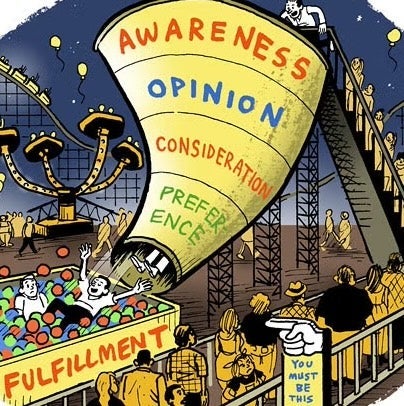Tradeshows are one of the most effective B2B marketing tools available. Attendees are highly committed to learning because of the intensiveness of the show experience. While you may use the Internet and search engines to generate awareness and product information, there is nothing better than being able to meet, qualify and have a meaningful dialogue with a prospective buyer or decision influencer.
Within a few short days, your company can gather leads, build your brand image, interact with new and current customers and launch products. Unlike many other marketing media, tradeshows allow you to control your environment and the image of your company, so you can make a big impression on current and prospective buyers.
The size of your booth isn’t nearly as important as how you present the company and how effective your team is at engaging qualified attendees and following up with interested buyers.
Chief Marketer Involvement + Planning + Execution + Follow-up = Success
Chief Marketers must lead the effort and resist delegation of tradeshow strategy. Your leadership, mentoring, encouragement and demands for verifiable returns will pay substantial dividends.
It’s critical to define quantifiable goals, set up measurement tools, and challenge marketing and sales staff to align tactics with your company’s marketing strategy. It may sound basic, but so many times “budget” takes precedent over “business objectives”.
Consider and specify your goals. Here are most common top 10 reasons exhibitors participate in tradeshows:
- Collect qualified leads from prospective customers.
- Launch new products or relaunch existing products.
- Meet with current customers and build relationships.
- Re-connect with lapsed customers.
- Conduct research among your target audience.
- Showcase the expertise of exceptional staff (e.g. engineers) that may have little customer interaction.
- Re-energize your sales force or partners with training activities around the event.
- Find joint venture organizations.
- Sell to other exhibitors.
- Sell products/take orders for future delivery.
Exhibit at only the “Right Shows”
Before you sign a contract for an exhibit booth, it’s critical to assess the fit” between the “purchasing power” of attendees and your products/services.
Make sure your marketing team asks the right questions of show organizers, so that you’ll exhibit at only the “right shows”. Here are some key questions/issues that will ensure that you invest only in appropriate events:
- Describe the event to me and what makes it different from others?
- Request detailed demographics of who attended the prior show. (Note: resist asking the “HOW MANY ATTENDEES” question). Large numbers are irrelevant if they don’t buy what you sell. Get job titles, company size, how many people actually attended that buy your product category. Nearly all show organizers will be pleased to provide demographic information to exhibitors that ask.
- Ask which industry magazines and online partners participate as sponsors—compare this to your advertising schedule to compare buyer audiences. Remember tradeshows can multiply your marketing with their activities.
- Identify what marketing tools the show organizer includes as part of the basic exhibit package (e.g. web listings and links to your website, free attendance tickets to your prospective clients, etc.). Ask for additional program options and factor what these extras can do to help you attract key buyers to your booth.
- Inquire about the availability and cost of lists (mailing or email) of attendees from prior shows to which you can do your own pre-show marketing. Ask if the show organizer can email your company website logo-URL as part of its own attendee marketing programs. Do be aware of issues related to CAN-SPAM in sending emails to the show organizer’s lists if they are not “opt-in”.
This is the first in a two part article for Chief Marketing Officers of B2B organizations that use tradeshows as substantial components of its marketing mix. The first part focuses on show selection and planning, while the second article describes on-site and post show actions that can ensure your organization gets the best returns on its investment.
Howard Friedman is a former vice president of Reed Exhibitions, group director of Nielsen Business Media (formerly VNU Expo), and is now the principal of his own tradeshow marketing strategy and business development consulting practice near Los Angeles. For additional helpful tools, visit http://www.hftradeshow.com. He can be reached at howard@hftradeshow.com.
 Network
Network

